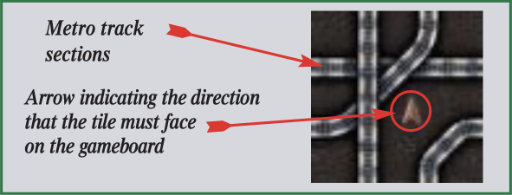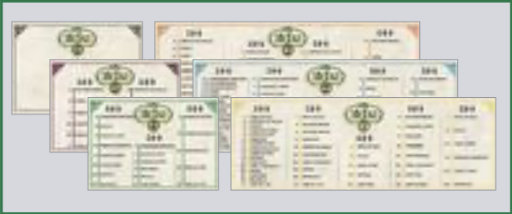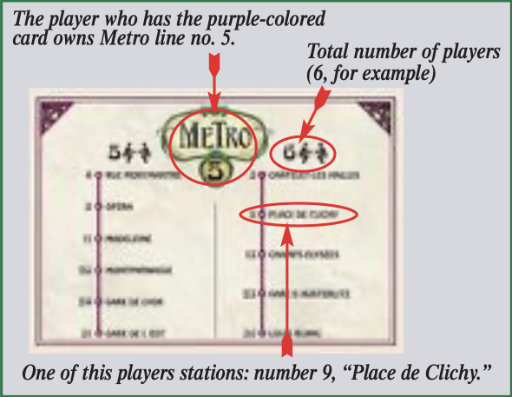Metro
Game Components
60 “track” tiles
Each one has 4 track sections.
Each tile side comes with 2 connectors.
Also, a red arrow shows the direction the tile must always face when laid on the gameboard

6 “metro line” cards

Each of them is in a different color, and is numbered from 1 to 6.
Depending upon how many players are in the game, each card will show the stations owned by each player, as well as the number assigned to each station.

61 subway cars
These are made of wood in six different colors.
They are used to indicate which Metro stations are owned by which player.

1 gameboard
The outer edge of the gameboard serves as a 0-to-100 point counter.
There are 32 “Metro” (subway) stations spread out over the gameboard, each with its own number. Each station has two tracks. The players must place their subway cars on the right side of the Metro station (the side with no roof). This track is the one by which subway cars can leave the station, while the other track (the one with a roof) indicates the end of a Metro line.
Players place tiles that form their own Metro lines on the 60 squares of the gameboard.
In the center of the gameboard are 8 Metro stations. The player who manages to connect one of his Metro lines to one of these stations doubles the winning points scored by that line.
6 colored pawns
There are 6 wooden pawns, each in a different color. Players take a pawn in the color of their choice. This pawn is used to keep a running tally of their points on the points track running around the gameboard’s outer edge.

Game Setup
- The gameboard is placed in the middle of the table.
- Each player receives a set of colored subway cars according to the following table:
- 2 players, 16 stations, yellow/blue
- 3 players, 10 stations, yellow/blue/orange
- 4 players, 8 stations, yellow/blue/orange/green
- 5 players, 6 stations, yellow/blue/orange/green/purple
- 6 players, 5 stations, all colors
- Then, each player takes the pawn in his color and places it on the “0” square of the points track.
- Each player takes the “Metro Line” card that matches his color. On it are printed the names and numbers of the Metro stations that belong to that particular player, which will depend on the number of players in the game.
- Now, each player places a subway car in his color on the outgoing track in each station that he owns.
- Extra subway cars are returned to the box and will not be used during play.
- “Rail” tiles are shuffled and placed next to the gameboard, “Metro” side facing up. This is the track pool.
- Each player picks up one tile and looks at it.
How to Play the Game
The youngest player play first. Each of the other players then take turns clockwise.
Placing “Track” Tiles on the Gameboard
Each player takes a turn laying down a “Track” tile on the gameboard. Whenever a player cannot, or does not want to, lay down the tile that he is holding, the player picks up a new tile, as long as there are any available in the pool, which he then must place on the gameboard.
These 4 conditions must be followed when laying down tiles:
- Each tile must be placed on an empty square. That square must border on (be adjacent to) a tile already laid down, or be placed along the edge of the gameboard. A tile may not be placed next to one of the central station squares unless it completes or continues an existing track.
- The tiles must always conform to (be facing in) the same direction as the red arrow on the gameboard.
- A tile may not be placed so that the tracks printed on it begin and end in the same station. The only exception would be if that tile could not be placed elsewhere (this rarely happens except in the endgame).
- A tile may be placed up against an opponents Metro subway departure point or up against one of its Metro lines, but the tile must be placed according to the instructions in all other game rules.
After laying down a tile, the player picks up a new tile, as long as one is available, unless he still is already holding one (thus, a player may only ever have one tile in their hand at the end of his turn).
Players whose Metro stations are all connected by a network of lines must place their tiles elsewhere.
Metro lines that do not belong to anyone may sometimes be formed on the gameboard. These lines are not subject to any special restrictions and do not affect the outcome of the game.
Adding Up Winning Points
As soon as a Metro line forms one continuous track from its departure station to any arrival station (either one of a players own stations, or one belonging to another player), the winning points scored by that line are tallied. Each tile that is part of a track is worth 1 winning point. If the line passes over the same squares several times, the winning points are added up for each time the line passes over them. If the line ends in one of the central stations, the total number of points for that line is doubled.
Each player uses his colored pawn to keep a running tally of his points around the edge of the gameboard.
After the points are counted, the subway car of the completed line must be turned 90º, because each station can only be counted once in each game (or, it can be simply removed from play).
End of the Game
The game is over when all the tiles have been laid on the gameboard. The winner is the player who has scored the highest number of points.
Game Variations
- To increase their tile-laying options, players can disregard the direction in which the arrows are pointing.
- Players can also choose to hold more tiles (2 or 3), which will make the game last longer.
Credits
- Game Designer: Dirk Henn
- Graphics: Franz Vohwinkel
- Development: Bernd Dietrich